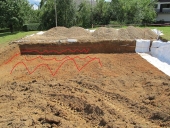Last months have been busy, working out for a bit of cash, traveling for some weeks on a Anti-Fracking biketour we also managed to put windows and door on place, and plaster most of the building

where it started:
https://permies.com/t/43534/timber/Ruin-structure-sketch-Roundwood-tiny
until now, for the stone wall and the light clay walls, we've been digging earthy-clay from the forest nearby, by hand,
for the plastering we bought 1000kg of clay, pure pinkish clay, we bought the raw material from a factory that produces expanded clay pellets, it costed less than 15 euros,
the clay was already processed (grinded and humidfied?) on the factory, we soaked it in barrels and used that paste on a cement mixer with sand
for the first outside plastering we used a 1 clay 3 sand 1 straw (cut to less than 5 cm pieces), it was pretty easy to spread it and the pieces of straw helped covering very easy most of the wood from the LSC structure,
the second outside plaster mixture was 1 clay 3 thinner sand
on the inside we didn't add straw to the mix so that the plaster layer isn't so thick we also experiment 2 walls with the forest clay to check color diferences
around windows and visible beams we stapled some neting to avoid cracking.... also passed a wet sponge on the plaster where cracks appeared - seems to have worked
will add some pics of the process







